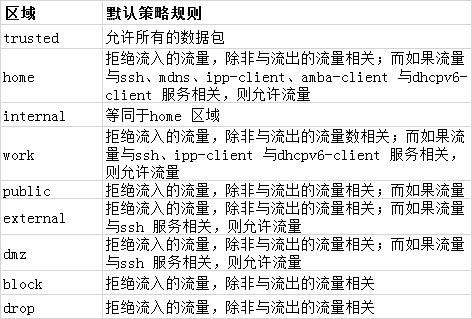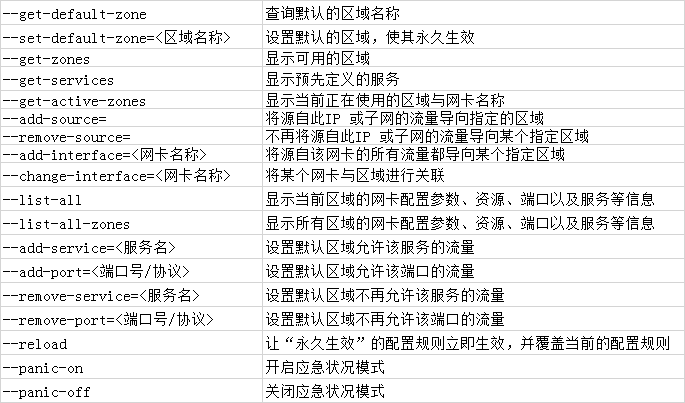1.firewalld 中常用的区域名称及策略规则

2.firewalld-cmd 命令中使用的参数以及作用

与 Linux 系统中其他的防火墙策略配置工具一样,使用firewalld 配置的防火墙策略默认为运行时(Runtime)模式,又称为当前生效模式,而且随着系统的重启会失效。
如果想让配置策略一直存在,就需要使用永久(Permanent)模式了,方法就是在用firewall-cmd 命令正常设置防火墙策略时添加--permanent 参数,这样配置的防火墙策略就可以永久生效了。
但是,永久生效模式有一个“不近人情”的特点,就是使用它设置的策略只有在系统重启之后才能自动生效。如果想让配置的策略立即生效,需要手动执行firewall-cmd --reload 命令。
查看 firewalld 服务当前所使用的区域:
[root@centos ~]# firewall-cmd --get-default-zone
public
查询ens33 网卡在firewalld 服务中的区域
[root@centos ~]# firewall-cmd --get-zone-of-interface=ens33
public
把 firewalld 服务中ens33 网卡的默认区域修改为external,并在系统重启后生效。分别查看当前与永久模式下的区域名称:
[root@centos ~]# firewall-cmd --permanent --zone=external --change-interface=ens33 success [root@centos ~]# firewall-cmd --get-zone-of-interface=ens33 external [root@centos ~]# firewall-cmd --permanent --get-zone-of-interface=ens33 no zone
把 firewalld 服务的当前默认区域设置为public:
root@centos ~]# firewall-cmd --set-default-zone=public success [root@centos ~]# firewall-cmd --get-default-zone public
启动/关闭firewalld 防火墙服务的应急状况模式,阻断一切网络连接(当远程控制服务器时请慎用):
[root@centos ~]# firewall-cmd --panic-on success [root@centos ~]# firewall-cmd --panic-off success
查询 public 区域是否允许请求SSH 和HTTPS 协议的流量:
[root@centos ~]# firewall-cmd --zone=public --query-service=ssh yes [root@centos ~]# firewall-cmd --zone=public --query-service=https no
把 firewalld 服务中请求HTTPS 协议的流量设置为永久允许,并立即生效:
[root@centos ~]# firewall-cmd --zone=public --add-service=https success [root@centos ~]# firewall-cmd --permanent --zone=public --add-service=https success [root@centos ~]# firewall-cmd --reload success
把 firewalld 服务中请求HTTP 协议的流量设置为永久拒绝,并立即生效:
[root@centos ~]# firewall-cmd --permanent --zone=public --remove-service=http Warning: NOT_ENABLED: http success [root@centos ~]# firewall-cmd --reload success
把在firewalld 服务中访问8080 和8081 端口的流量策略设置为允许,但仅限当前生效:
[root@centos ~]# firewall-cmd --zone=public --add-port=8080-8081/tcp success [root@centos ~]# firewall-cmd --zone=public --list-ports 8080-8081/tcp
把原本访问本机 888 端口的流量转发到22 端口,要且求当前和长期均有效:
流量转发命令格式为 firewall-cmd --permanent --zone=<区域> --add-forward-port=port=<源端口号>:proto=<协议>:toport=<目标端口号>:toaddr=<目标IP 地址>
[root@centos ~]# firewall-cmd --permanent --zone=public --add-forward-port=port=888:proto=tcp:toport=22:toaddr=192.168.10.10 success [root@centos ~]# firewall-cmd --reload success
firewalld 中的富规则表示更细致、更详细的防火墙策略配置,它可以针对系统服务、端口号、源地址和目标地址等诸多信息进行更有正对性的策略配置。它的优先级在所有的防火墙策略中也是最高的。
比如,我们可以在firewalld 服务中配置一条富规则,使其拒绝192.168.10.0/24 网段的所有用户访问本机的ssh 服务(22 端口):
[root@centos ~]# firewall-cmd --permanent --zone=public --add-rich-rule=" rule family="ipv4" source address="192.168.10.0/24" service name="ssh" reject" success [root@centos ~]# firewall-cmd --reload success
在客户端使用 ssh 命令尝试访问192.168.10.10 主机的ssh 服务(22 端口):
[root@client A ~]# ssh 192.168.10.10 Connecting to 192.168.10.10:22... Could not connect to '192.168.10.10' (port 22): Connection failed.